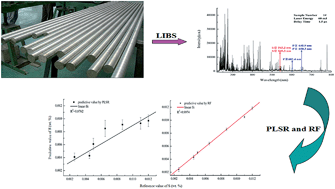Quantitative analysis of nonmetal elements in steel using laser-induced breakdown spectroscopy combined with random forest
Abstract
Laser-induced breakdown spectroscopy (LIBS) combined with random forest (RF) was proposed for the quantitative analysis of sulfur (S) and phosphorus (P) in steel samples. The interference from the characteristic spectral lines of S and P in steel is difficult to accurately quantitatively analyse due to the influence of the multi-matrix. A RF model was utilized to compensate for the negative influence of the matrix effect. The influences of laser pulse energy and delay time on the spectral intensity were studied to improve the signal-to-noise ratio (SNR) of the analytical line for a certain element. Furthermore, the parameters (ntree and mtry) of the RF model were optimized by out-of-bag (OOB) estimation. The final RF calibration model for the quantitative analysis of S and P in steel was constructed using the spectral range (520–620 nm) as an input variable under the optimized experimental conditions. Results showed that the RF calibration model made good predictions of S (R2 = 0.9974) and P (R2 = 0.9981) compared with partial least square regression (PLSR), using the peak signals of S II 545.3 nm and P II 602.4 nm, respectively. The averaged relative errors (ARE) of S in steel were 2.69% and 3.47% for samples #8 and #9, respectively, and of P were 1.77% and 0.83% for samples #8 and #9, respectively. This confirms that the RF model is a promising approach for the quantitative detection of the nonmetal elements with LIBS technology in the field of metallurgy.


 Please wait while we load your content...
Please wait while we load your content...